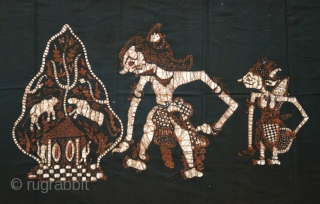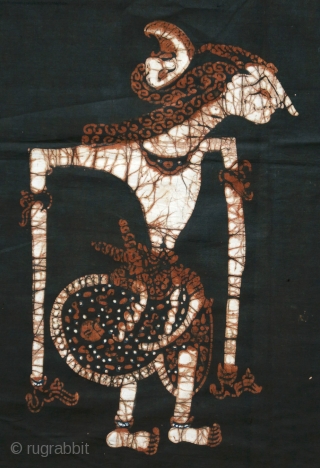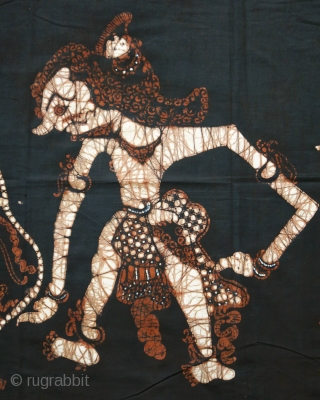Back
Javanese Batik Wall Hanging with Wayang Figures
Origin: Indonesia, Java, Jogjakarta, 1940 – 1960
Technique: Commercial cotton, mixed dyes, hand-drawn (tulis) batik
Description: a dramatic batik hanging from Jogjakarta, hand-drawn with wayang kulit (shadow puppet drama) figures in the traditional colors of soga brown and white, with a few indigo blue highlights, on a black ground. The design presents the palm leaf shaped gunungan (mountain), the symbol of the world in Hindu cosmology, at the center as it is at the start of a wayang kulit performance, separating the 2 pairs of opposing figures. The mountain is internally articulated by a tree of life, at the base of which is a small building with closed doors guarded by mythical creatures.
The imposing scale of the human figures is enriched by the design and decoration of their clothing and headdress. They are drawn in the stylized manner of the painted leather puppets, their thin elongated arms, elaborate head-dresses, and angular profiles. The smaller figures wear the kris (ceremonial dagger), shown by the handles protruding behind the waist. The figures vary in feature, posture, and decoration, creating a richly animated design. Of particular note are the batik patterns they wear folded in the manner of the court costume dodot, creating a self-reflexive “batik within batik” effect!
The fine veining of the figures is created by a special technique for crackling the wax during the dye process to allow threads of dye color, and even a marbling effect, to appear on the undyed white ground. This gives added dimension to the graphic interplay of light and dark in the figures.
Context: The traditional batik of Jogjakarta can be distinguished by its bright white combined with a reddish soga brown, as opposed to the more muted combination of cream and golden brown in Solo. This graphic color composition enhances the Jogjakarta style of large, geometric motifs in a strong dramatic design.
Wayang kulit is a popular traditional entertainment shared by the court and the ordinary people. The court puppets are beautifully painted, and the handles that manipulate their jointed arms made of horn. Their primary characterization and expression is created by profile, movement, posture and delicate openwork. It has been said that the design of central Javanese batiks expresses the basic aesthetic of wayang kulit, where elements are placed in layers, and project the chiaroscuro of light and shadow.
Condition: The textile is in excellent condition, with no holes, stains, or tears. The black is deep, the white is bright, and the soga brown is a particularly rich shade of dark red-brown. The cotton is densely woven, and of the slightly rough grade used for wall hangings rather than clothing, and has grown quite crisp with age.
Dimensions: Length: 186 cm. Width: 103.5 cm.
Origin: Indonesia, Java, Jogjakarta, 1940 – 1960
Technique: Commercial cotton, mixed dyes, hand-drawn (tulis) batik
Description: a dramatic batik hanging from Jogjakarta, hand-drawn with wayang kulit (shadow puppet drama) figures in the traditional colors of soga brown and white, with a few indigo blue highlights, on a black ground. The design presents the palm leaf shaped gunungan (mountain), the symbol of the world in Hindu cosmology, at the center as it is at the start of a wayang kulit performance, separating the 2 pairs of opposing figures. The mountain is internally articulated by a tree of life, at the base of which is a small building with closed doors guarded by mythical creatures.
The imposing scale of the human figures is enriched by the design and decoration of their clothing and headdress. They are drawn in the stylized manner of the painted leather puppets, their thin elongated arms, elaborate head-dresses, and angular profiles. The smaller figures wear the kris (ceremonial dagger), shown by the handles protruding behind the waist. The figures vary in feature, posture, and decoration, creating a richly animated design. Of particular note are the batik patterns they wear folded in the manner of the court costume dodot, creating a self-reflexive “batik within batik” effect!
The fine veining of the figures is created by a special technique for crackling the wax during the dye process to allow threads of dye color, and even a marbling effect, to appear on the undyed white ground. This gives added dimension to the graphic interplay of light and dark in the figures.
Context: The traditional batik of Jogjakarta can be distinguished by its bright white combined with a reddish soga brown, as opposed to the more muted combination of cream and golden brown in Solo. This graphic color composition enhances the Jogjakarta style of large, geometric motifs in a strong dramatic design.
Wayang kulit is a popular traditional entertainment shared by the court and the ordinary people. The court puppets are beautifully painted, and the handles that manipulate their jointed arms made of horn. Their primary characterization and expression is created by profile, movement, posture and delicate openwork. It has been said that the design of central Javanese batiks expresses the basic aesthetic of wayang kulit, where elements are placed in layers, and project the chiaroscuro of light and shadow.
Condition: The textile is in excellent condition, with no holes, stains, or tears. The black is deep, the white is bright, and the soga brown is a particularly rich shade of dark red-brown. The cotton is densely woven, and of the slightly rough grade used for wall hangings rather than clothing, and has grown quite crisp with age.
Dimensions: Length: 186 cm. Width: 103.5 cm.
price:
USD 95
- Home
- Antique Rugs by Region
- Category
- Profiles
- Post Items Free
- Albums
- Benaki Museum of Islamic Art
- Budapest: Ottoman Carpets
- Gulbenkian Museum
- Islamic Carpets. Brooklyn
- Islamic Textiles. Brooklyn
- Konya Museum: Rugs
- MKG, Hamburg
- MMA: Caucasian Carpets
- MMA: Mamluk Carpets
- MMA: Mughal Indian Carpets
- MMA: Ottoman Carpets
- MMA: Safavid Persian Carpets
- MMA: Turkmen Rugs
- McCoy Jones Kilims
- Ottoman textiles. Met
- Philadelphia Museum
- Rugs and Carpets: Berlin
- Seljuqs at the Met
- TIEM, Istanbul: Carpets
- V&A: Classical Carpets
- Vakiflar Carpets: Istanbul
- Baluch Rugs: Indianapolis
- Gallery Exhibitions
- Jaf an Exhibition
- Alberto Levi Gallery
- Andean Textile
- Christie's London: 2016
- Francesca Galloway
- HALI at 40
- ICOC Washington, DC 2018
- Jajims of the Shahsavan
- London Islamic Week April, 2018
- Mongolian Felts
- Navajo Rugs: JB Moore
- Persian Piled Weavings
- SF Tribal & Textile Art Show 2020
- SF Tribal 2019
- Sotheby's: C. Alexander
- Turkish Prayer Rugs
- Turkmen Main Carpets ICOC 2007












